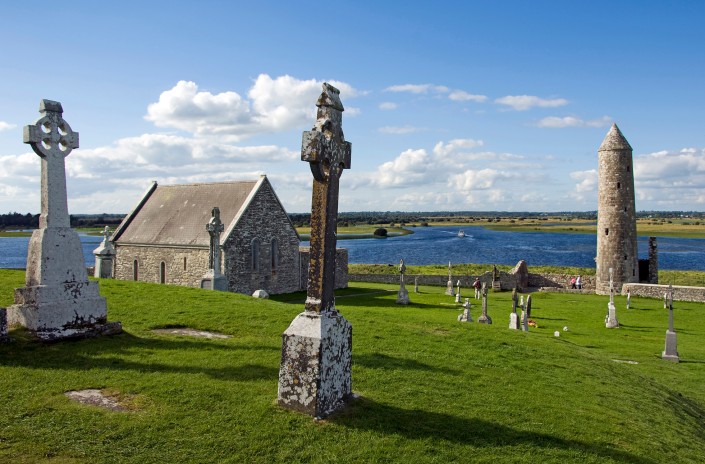There are some must-visit locations for anybody coming to Ireland and Clonmacnoise must be one of them. One of Ireland’s most important monasteries, it is located on the banks of the River Shannon and was founded in 545 by a young man, Saint Ciaran of County Roscommon.
This ancient center of learning, trade, religion and craftsmanship now houses an interpretative center which is open to the public and tells the story of this most special place.

Because Clonmacnoise was in such a strategic location in County Offaly south of Athlone, it became a major center for religion and learning and was visited by scholars from all over Europe. Clonmacnoise or Cluain Mhic Nois in Irish means ‘Meadow of the Sons of Nos’. From the ninth until the eleventh century, it was allied with the Kings of Meath and indeed many of the High Kings of Tara and Connacht were buried there.
Ciaran was said to have arrived at Clonmacnoise, having traveled along the major land route through mostly bog land in central Ireland on the main east / west route along the Esker Riada, which is an esker left from the original glaciers of the last ice-age. He then set about building the first small wooden church at the site, with the help of Diarmait Ui Cerbaill, who was the first Christian crowned High King of Ireland. Ciaran died of the plague in his early thirties and is said to be buried under the original church, which was replaced by a stone oratory.
Clonmacnoise grew greatly between the 8th and 12th centuries and became associated with great treasures including the Clonmacnoise Crozier (now housed in the National Museum of Ireland) and the Cross of the Scriptures. It began to decline, however, with the growth of the town of Athlone, which became the main trading point of the Midlands and in later years when Ireland moved from a monastic framework to a diocesan one. Pope John Paul visited Clonmacnoise when he came to Ireland in 1979.
There are a number of key buildings, including two round towers and three high crosses of huge historical significance at Clonmacnoise, the most well-known being Temple Finghin and McCarthy’s Tower, the 12th century Romanesque church and round tower.
Most of the seven churches at the site have undergone conservation. Temple Connor is used by the Church of Ireland since the 18th century and every Sunday during the summer there is a service held there.
The Cross of the Scriptures, made from Clare sandstone, is one of Ireland’s important high crosses and has been moved indoors at the site while a replica remains outside.
The Cathedral is the largest of all the churches at Clonmacnoise and has enormous resonance as it is the location where the last High King of Ireland, Rory O Connor was buried.
Clonmacnoise is a magical counterpoint of the history of Ireland and in addition to the largest collection of Early Christian grave slabs in Western Europe, the area is also important in terms of flora, fauna and landscape.